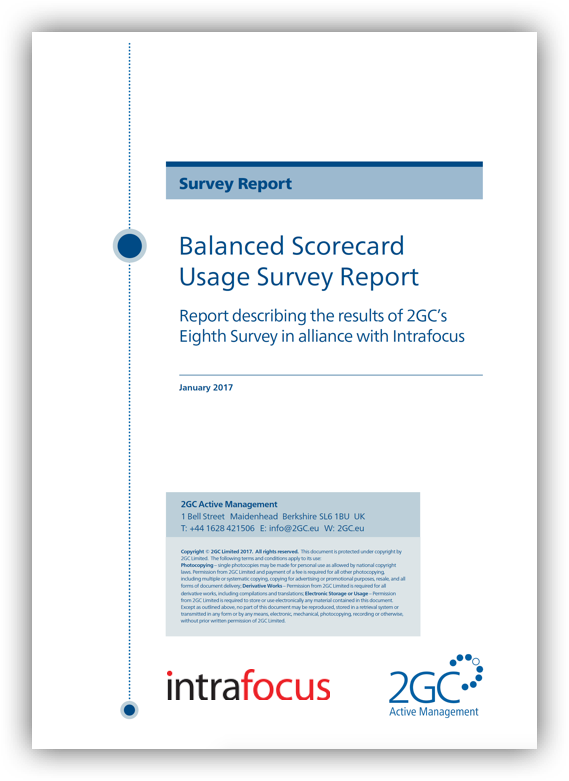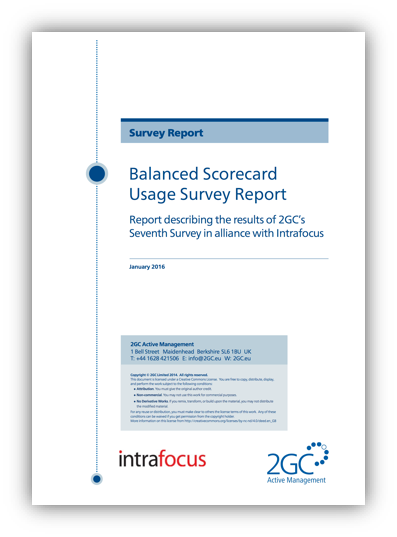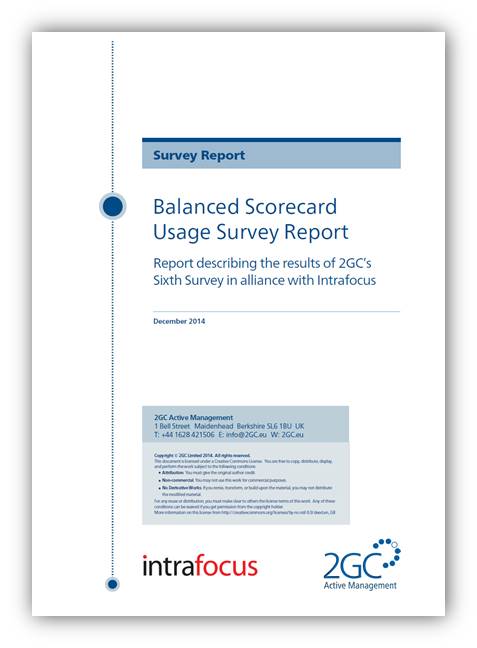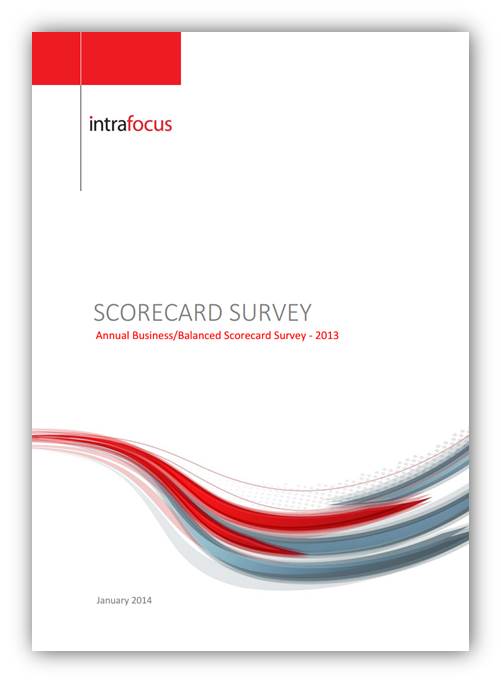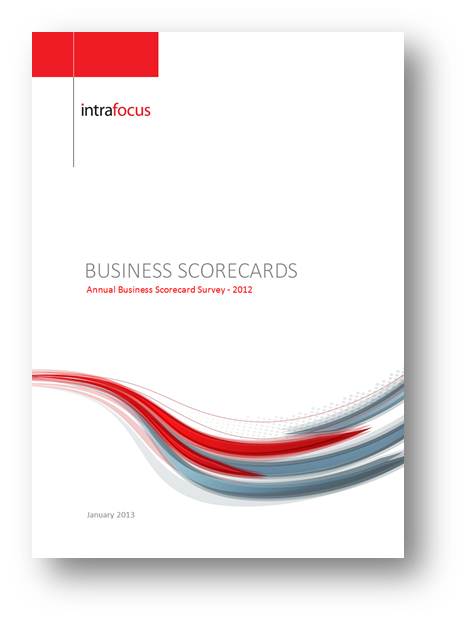Balanced Scorecard Survey – 2016
Executive Summary
The annual Balanced Scorecard Survey run by Intrafocus and 2GC had an excellent response this year. As in previous years over three quarters of those responding reported that their Balanced Scorecard was ‘extremely’ or ‘very’ useful.
Once again respondents identified the importance of the organisation supporting the Balanced Scorecard for it to be useful. As this respondent noted:
“Important lesson learnt: management must lead. It is critical that the implementation and usage of the BSC be supported by/led/championed at the highest level in the organisation, in order for the system to have the required influence on performance (including consequences for shortfall in performance).“
Culture was again mentioned as an important component of successful implementation:
“We started using a balanced scorecard approach around five years ago but it has only been in the past two years that we have been comfortable with business management using this process. It has taken a while to bed-in. This is more a cultural statement than anything else.“
Balanced Scorecard works by changing the behaviour of managers within the organisation: to be implemented successfully a Balanced Scorecard project needs to be considered just part of a more extensive change management programme – if you do not make it possible for managers to change their decision-making habits and behaviours, it will be hard to get value out of this valuable strategic management tool.
Notable characteristics of this year’s survey are:
- This year the proportion of respondents from the Americas and the Middle East were higher, as were the number of respondents from not-for-profits and government organisations.
- A surprisingly high number of respondents do not use any software tools to report their Balanced Scorecard. 33% of respondents were using MS office tools, such as Excel spreadsheets. Quickscore was the most commonly used specialist software. These findings do reveal an opportunity – with a few adjustments most organisations would see better returns on their investment. Introducing software automation to ensure more frequent reporting and trigger the changes which result in consequences could make Balanced Scorecard performance more effective.
- Organisations report that Balanced Scorecards ‘work’ by influencing the actions and behaviours of managers. However, it is not universally true – a small but significant number of organisations use Balanced Scorecard but say that there are no consequences for missing targets. For Balanced Scorecard to be effective, it needs to be used in more than an advisory capacity.
- A majority of respondents reported links between their Balanced Scorecards and Planning and Budgeting processes, and just less than half with Quality and a third with Risk management – this is very encouraging as it shows how well integrated the tool is with general management practices.
2016 Report
Download a copy of the final report. Together with the executive summary opposite it contains all of the charts and graphs associated to the questions asked and a complementary analyst narrative.
For more information, please contact us via our Help Desk
Balanced Scorecard Survey – 2015
Executive Summary
This year we again had a really good response to the survey, and as per last year over two thirds of those responding reported that their Balanced Scorecard was ‘extremely’ or ‘very’ useful. However it was notable that many respondents identified the importance of the organisation supporting the Balanced Scorecard for it to be useful. For example, some noted the need for strong sponsorship from the organisation’s leaders when implementing a Balanced Scorecard.
Others mentioned the value of establishing the “culture” of performance management. Our experience is that Balanced Scorecard works by changing the behaviour of managers within the organisation, and so to be implemented successfully a Balanced Scorecard project should be considered within the context of a more extensive change management programme – we see this as essential to get value out of this valuable strategic management tool. Notable characteristics of this year’s survey are:
- This year the proportion of respondents from the Americas were lower, but we had an equivalently greater response from respondents in Asia and the Far East.
- As we found in previous surveys, the most common usage for Balanced Scorecard is at the Executive level, and the most common role for Balanced Scorecard is to inform on strategy implementation activities.
- Most of the respondents reported that their Balanced Scorecards have measures and targets BUT in some cases not all the metrics are fully defined and not all the targets have been set – an indication that the design of the Balanced Scorecard is incomplete.
- As we found in previous surveys, the reported Balanced Scorecards ‘work’ by influencing the actions and behaviours of managers within the organisation. However around 50% of respondents say that there are no consequences for missing targets, which is curious. We firmly believe that a Balanced Scorecard will work far more effectively if managers are held accountable for the results it reports.
- A majority of respondents reported links between their Balanced Scorecards and Planning and Budgeting processes, and around half with Quality and Risk management – this is very encouraging as it shows how well integrated the tool is with general management practices.
2015 Report
Download a copy of the final report. Together with the executive summary opposite it contains all of the charts and graphs associated to the questions asked and a complementary analyst narrative.
For more information, please contact us via our Help Desk
Balanced Scorecard Survey – 2014
Executive Summary
This year a number of respondents referred to the need to take extra care with implementing a Balanced Scorecard in order to ensure it is able to influence management decision-making behind strategic and operational success. Some quotes from respondents illustrate this:
- “In its first year it has improved management alignment and focus on key issues. Has highlighted the importance of quantifying performance”
- “Balanced Scorecard drives performance to achieve a shared vision”
- “We have only been using it for a little over a year and have been finding our way
somewhat. The value has been increasing as we capture more measures and help
departments develop their lead measures. Many people don’t know what they want
until you show them something they don’t want. They also don’t see the value until it
has captured some data over time. But once you have some champions on board it
builds its own momentum”
The highlights of this year’s findings are as follows:
- Respondents from Europe are up on previous years.
- Operational use of the Balanced Scorecard shows an increase, with nearly 60% of respondents mentioning this.
- Quality management links have grown again this year, as has mention of internal processes which is the most used as a perspective heading, reflecting a desire to use the tool to ensure greater organisational efficiency and effectiveness in this age of economic austerity.
- Actions and Behaviours are strongly influenced by the tool but 50% of respondents say that there are no consequences for missing targets – we believe a Balanced Scorecard needs ‘teeth’! Two-thirds of respondents said that their Balanced Scorecards are linked to Planning and Budgeting processes.
- The tool is seen to be ‘extremely’ or ‘very’ useful by over three-quarters of users.
2014 Report
Download a copy of the final report. Together with the executive summary opposite it contains all of the charts and graphs associated to the questions asked and a complementary analyst narrative.
For more information, please contact us via our Help Desk
Business Scorecard Survey – 2013
Executive Summary
Now is the time for businesses and organisations of all sizes to step up to the challenge of a greater competitive marketplace and create effective strategies for growth.
Using a balanced or business scorecard will not provide the whole solution, but with it there is clear evidence that strategic management will be much more effective.
This survey was designed to examine business scorecard usage within companies and organisations and to provide an insight into where and how they are used. The respondents were told this was not a survey specific to balanced scorecard usage. All scorecard types were considered valid.
However, it has become clear from the results and through working with many of the respondents direct, that the methodology behind the ‘Balanced Scorecard’ as defined by Kaplan and Norton and organisations like the Balanced Scorecard Institute, has become a driving force to align businesses and organisations to their strategies.
The following key points can be gleaned from this survey:
- The vast majority of scorecards are still spreadsheet based.
- The use of dedicated technology to manage strategy, objectives, metrics and initiatives appears to be growing.
- Businesses and organisations seem to prefer to utilise methodologies as defined by Balanced Scorecard institutes to help orchestrate change in their organisations.
- The number of businesses and organisations that see scorecard usage as a means to make improvements (rather than record progress) is growing.
- A large number of businesses and organisations believe that the scorecard process is an instrument for strategic change.
- Only a few businesses and organisations are ‘highly satisfied’ with their scorecard approach, many believe there is much room for improvement.
The results of this survey and the same survey conducted last year suggest that the use of scorecards and specifically Balanced Scorecards is seen as a positive thing. Although some respondents were frustrated with the time taken to build a scorecard regime, they all wanted the approach to succeed and saw enough benefits to persist.
It was also clear that the terminology ‘Business Scorecard’ was confusing and as such next year the survey will be renamed as a Balanced Scorecard Survey.
2013 Report
Download a copy of the final report . Together with the executive summary opposite it contains all of the charts and graphs associated to the questions asked and a complementary analyst narrative.
For more information, please contact us via our Help Desk
Business Scorecard Survey – 2012
Executive Summary
The biggest challenge facing companies and organisations of all sizes today is how to drive their businesses out of the current economic recession. To do this, focus has to be put on managing operational activities effectively and building and managing strategies for change.
In the past, strategic execution has not been a highly developed process for most companies and organisations. Therefore it has been difficult to manage strategic change. Although a business scorecard should not be seen as the ‘silver-bullet’ to enable strategic change, it can, if implemented properly, make a real difference.
This survey was designed to examine business scorecard usage within companies and organisations and to provide an insight into where and how they are used. The respondents were told this was not a survey specific to balanced scorecard usage. All scorecard types were considered valid.
The following key points can be gleaned from this survey:
- Scorecards are in use across all industries. The format of the scorecards varies considerably and seems to grow through specific company/organisational need.
- There is an emerging use of dedicated technology to manage strategy, objectives and KPI scorecards. However, the vast majority of scorecards are still spreadsheet based.
- There are still a small number of companies/organisations that manage their strategy, objectives and scorecards using free-form documentation.
- The majority of scorecards are used to simply report on progress ‘up-the-chain’. In other words they are a mechanism to ensure executive management is informed about the business. Of this majority most would view scorecard management as a required task, but not one that held great importance.
- Although there were no specific questions about objective and metric ownership, discussions revealed that this was the single most important contributing factor to a laissez-faire attitude toward the scorecard process, i.e. lack of ownership.
- There was also, however, a large minority who believed that the scorecard process was an instrument for positive strategic change.
- Over a third of the companies surveyed believed that the way in which their companies were measured could be improved; only a very small proportion was highly satisfied.
The results of this survey provide encouragement to both executive management and practitioners alike. Although there is still a majority view that things need to be measured just to monitor operations, there are areas such as the introduction of technology and scorecard use in strategic improvement that suggest more formal approaches have real value.
The Intrafocus Balanced Scorecard Survey
2012 Report
Download a copy of the final report. Together with the executive summary opposite it contains all of the charts and graphs associated to the questions asked and a complementary analyst narrative.

